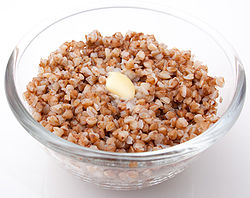Kasha
 Buckwheat kasha | |
| Type | Porridge |
|---|---|
| Main ingredients | Cereal (buckwheat, wheat, barley, oats, millet or rye) |


Kasha is a cereal eaten in Central and Eastern Europe (especially Russia, Ukraine and Poland)[like whom?] and the United States. This English-language usage probably originated with Jewish immigrants, as did the form קאַשי "kashi" (technically plural, literally translated as "porridges").[1]
The word kasha was introduced into American English by Jewish immigrants and it generally refers to roasted whole-grain buckwheat of buckwheat groats.[citation needed] However, in Slavic Europe, it refers to porridge in general and can be made from buckwheat or any cereal wheat, barley, oats, millet and rye. At least 1,000 years old, kasha is one of the oldest known dishes in Central European and Eastern European cuisine.[2][3]
In Russian, buckwheat is referred to formally as гречиха (grechikha) and buckwheat grain and buckwheat groats as гречневая крупа (grechnevaya krupa). Informally buckwheat grain and buckwheat groats are called гречка (grechka), and the porridge made from buckwheat groats is known as гречневая каша (grechnevaya kasha). In Polish, buckwheat porridge is referred to as kasza gryczana.
In Russian culture
Kasha is commemorated in the Russian saying "щи да каша – пища наша" (shchi da kasha – pishcha nasha) literally "shchi and kasha are our food" or, more loosely, "cabbage soup and porridge are all we need to live on".
In Jewish culture
As an Ashkenazi-Jewish comfort food, kasha is often served with onions and brown gravy on top of bow tie pasta, known as Kashe varnishkes (or Kasha varnishkas).[4] Kasha is a popular filling for knishes[5] and is sometimes included in matzah-ball soup.[citation needed]
See also
References
- ^ Steinmetz, Sol. Dictionary of Jewish Usage: A Guide to the Use of Jewish Terms. p. 42. ISBN 0-7425-4387-0.
- ^ Molokhovets, Elena (1998). Classic Russian Cooking. Indiana University Press. p. 331.
- ^ http://www.lesliebeck.com/ingredients/kasha
- ^ "Le Cordon Jew". May 22, 2008. Retrieved 2011-01-15.
- ^ [1]. Retrieved May 30, 2007.
